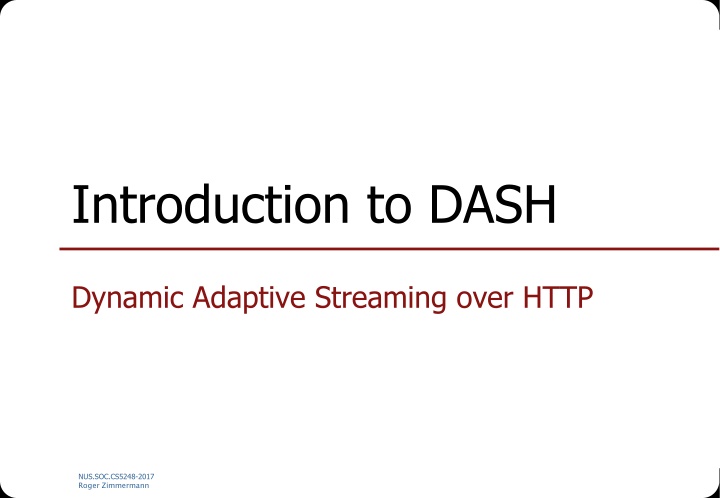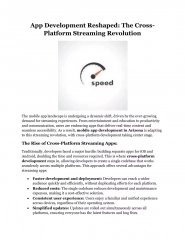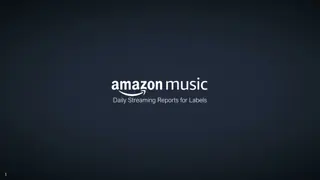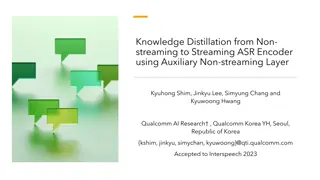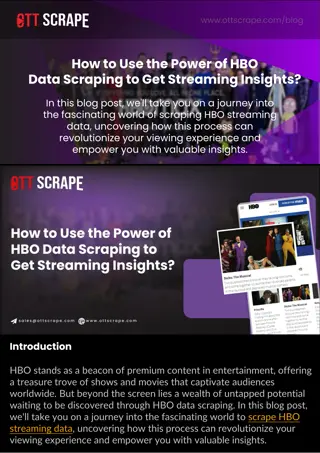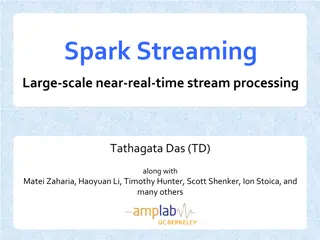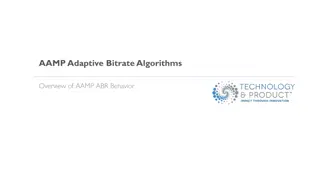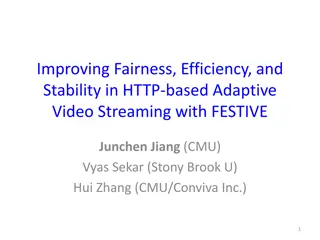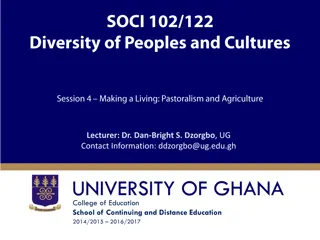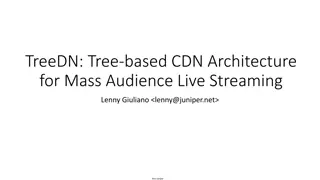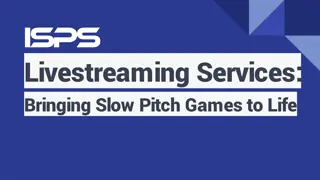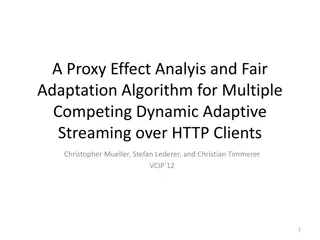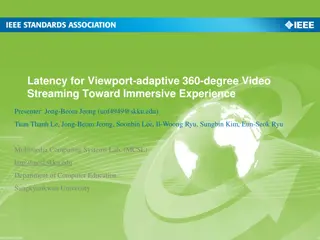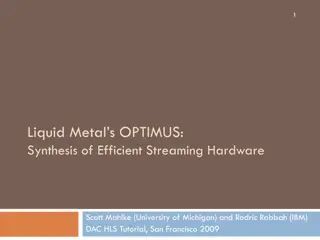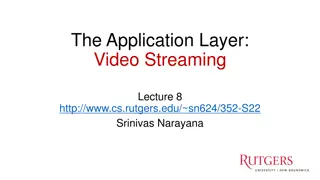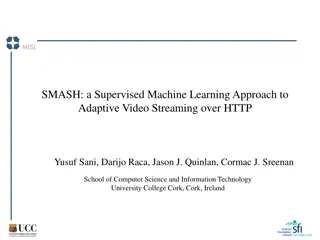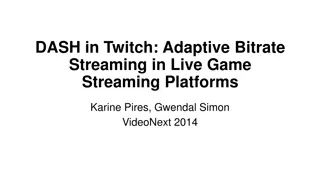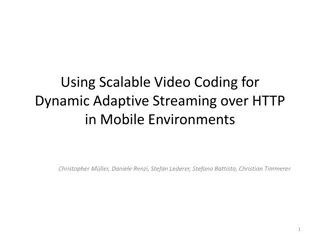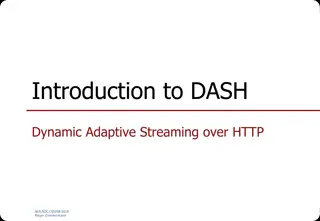Overview of Dynamic Adaptive Streaming over HTTP
Diving into the world of DASH (Dynamic Adaptive Streaming over HTTP) through a series of images and explanations. Learn about the challenges faced, the main idea behind DASH, its original implementation by Move Networks, the concept of MPD (Media Presentation Description), the role of web servers in providing playlists, the stateless nature of the HTTP protocol in DASH, and the functionality of DASH media players.
Download Presentation

Please find below an Image/Link to download the presentation.
The content on the website is provided AS IS for your information and personal use only. It may not be sold, licensed, or shared on other websites without obtaining consent from the author.If you encounter any issues during the download, it is possible that the publisher has removed the file from their server.
You are allowed to download the files provided on this website for personal or commercial use, subject to the condition that they are used lawfully. All files are the property of their respective owners.
The content on the website is provided AS IS for your information and personal use only. It may not be sold, licensed, or shared on other websites without obtaining consent from the author.
E N D
Presentation Transcript
Introduction to DASH Dynamic Adaptive Streaming over HTTP NUS.SOC.CS5248-2017 Roger Zimmermann
DASH (1) RTP/RTSP/RTCP streaming faces several challenges Special-purpose server for media (complex) Protocols use TCP and UDP transmissions (firewalls) Difficult to cache data (no web caching ) Advantage Short end-to-end latency NUS.SOC.CS5248-2017 Roger Zimmermann
DASH (2) Main idea of DASH Use HTTP protocol to stream media Divide media into small chunks, i.e., streamlets Advantages Server is simple, i.e., regular web server No firewall problems (use port 80 for HTTP) Standard (image) web caching works NUS.SOC.CS5248-2017 Roger Zimmermann
DASH (3) Original DASH implementation by Move Networks Introduced concept of streamlets Additional idea: make playback adaptive Encode media into multiple different streamlet files, e.g., a low, medium, and high quality version (different bandwidth) NUS.SOC.CS5248-2017 Roger Zimmermann
DASH (4) MPD: Media Presentation Description ISO/IEC Standard: Information technology MPEG systems technologies Part 6: Dynamic adaptive streaming over HTTP (DASH) JTC 1/SC 29; FCD 23009-1 NUS.SOC.CS5248-2017 Roger Zimmermann
DASH (5) Web server provides a playlist The playlist is a file in a specific format that lists all the available qualities and all the streamlets for each quality Playlist file extension is .m3u8/.mpd Content preparation: Original media file needs to be split into streamlets Streamlets need to be transcoded into different qualities NUS.SOC.CS5248-2017 Roger Zimmermann
DASH (6) HTTP protocol is stateless! Server remembers nothing about session Scheduling logic, etc., is in media player! NUS.SOC.CS5248-2017 Roger Zimmermann
DASH (7) DASH media player Loads .m3u8/.mpd file and then starts to download streamlets All the scheduling logic is in the player Render current streamlet while downloading the next streamlet before playback is done Measure bandwidth and switch between different qualities (i.e., adapt) Switch servers can be done easily NUS.SOC.CS5248-2017 Roger Zimmermann
DASH (8) Many media players now understand DASH streaming format Many companies use HTTP streaming: Apple, Microsoft, Adobe, Netflix, CDNs like this approach No need to run QuickTime, Windows Media, RealNetworks, and Flash streaming servers Just use web server for everything! NUS.SOC.CS5248-2017 Roger Zimmermann
DASH (9) TS versus ISOBMFF file formats MPD validator: http://www-itec.uni-klu.ac.at/dash/?page_id=605 NUS.SOC.CS5248-2017 Roger Zimmermann
Project Create a DASH-compliant (Dynamic Adaptive Streaming over HTTP) live streaming system NUS.SOC.CS5248-2017 Roger Zimmermann
Goals (1) Capture video on an Android tablet and store it as an MP4 file. Split the MP4 file into streamlets, i.e., 3 second long video files. Upload the streamlets to a web server. Transcode the streamlets into 3 different streamlets (e.g., low, medium, high quality). Create a playlist on the web server. NUS.SOC.CS5248-2017 Roger Zimmermann
Goals (2) Implement a simple Android DASH media player that streams the uploaded video. Advanced Goal: enable an end-to-end live streaming system i.e. all the above goals in an on-the-fly fashion. NUS.SOC.CS5248-2017 Roger Zimmermann
Tools and platforms Samsung Galaxy Note Pro running Android 5.x (Lollipop) OR Samsung S2 8.0 running Android 7.x (Nougat). Programming on Android is done in Java with the Android Studio IDE. On the web server, create scripts in PHP (default) or any web framework of your choice. NUS.SOC.CS5248-2017 Roger Zimmermann
Project Homepage Descriptions and web links Some utilities and some library source codes Documentation (RFCs, etc.) IVLE Forums, Slack (cs5248.slack.com) TA: Raj Joshi (rajjoshi@comp.nus.edu.sg) NUS.SOC.CS5248-2017 Roger Zimmermann
Logistics (1) An account will be created for each group on our server: monterosa.d1.comp.nus.edu.sg Your username and password will be emailed to you. Change the password! Use ssh or PuTTy or something similar to log in. The machine runs Linux (Ubuntu 16.04). You will need to know some minimal Linux commands: ls, mv, cd, chmod, NUS.SOC.CS5248-2017 Roger Zimmermann
Logistics (2) For your HTML and Python/PHP web server code you need to create a subdirectory called public_html. chmod 755 on your public_html directory (done for you this time!) chmod 644 on all web files (e.g., *.html, *.php) The public link will be: http://monterosa.d1.comp.nus.edu.sg/~yourteam NUS.SOC.CS5248-2017 Roger Zimmermann
Logistics (3) Below the public_html you need another directory (e.g. video_repo) to store your video files. This directory needs to have write permissions for group users. (already set for a new directory on Ubuntu) This is because www-data is added to your user group. NUS.SOC.CS5248-2017 Roger Zimmermann
Logistics (4) Every team will be given a MySQL account. The database name, username and password will be emailed to you. Use mysql command-line or phpMyAdmin GUI for database administration. phpMyadmin: monterosa.d1.comp.nus.edu.sg/phpmyadmin/ NUS.SOC.CS5248-2017 Roger Zimmermann
Logistics (5) Tools are accessible in /usr/local/bin: MP4Box, ffmpeg, ffprobe, mp4info Any other tools? -> email the TA Use Slack (or IVLE Forum) for discussions and questions: cs5248.slack.com NUS.SOC.CS5248-2017 Roger Zimmermann
Advice and Actions (1) Form a team (3 persons). Note: You will need to explore and learn a LOT. Your programming effort will be small. HTTP POST command structure MP4Parser/MediaCodec usage FFmpeg transcoder usage Playlist .m3u8 format in XML Start early (i.e., this week)! NUS.SOC.CS5248-2017 Roger Zimmermann
Actions (2): Get your Tablet Check out your loan tablet for the project from Mr. Chow from SoC Technical Services Counter (COM1-01-06). There is one tablet per team (3 students). Please loan your tablet on 4/9 or 5/9, 10:00-12:00 or 13:00-17:00. Email: chowcm@comp.nus.edu.sg. Tell Mr. Chow your team number and names of team members. NUS.SOC.CS5248-2017 Roger Zimmermann
More Advice (1) Design with live in mind, but implement incrementally. Work in parallel Capture client Server-side DASH Player client Use version-control and code backups NUS.SOC.CS5248-2017 Roger Zimmermann
More Advice (2) The teaching team is there to help, BUT We will NOT: debug your code answer queries that could be easily Googled We will: advise you on system design provide pointers to what in your system might be going wrong NUS.SOC.CS5248-2017 Roger Zimmermann
